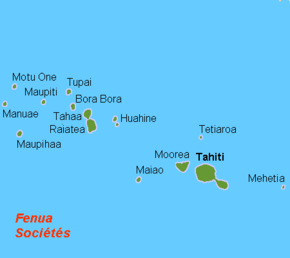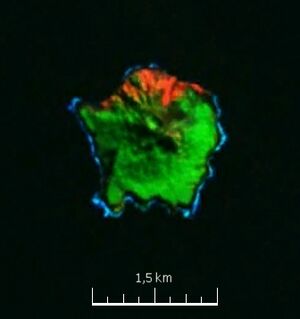Earth:Mehetia
| Native name: Meheti'a | |
|---|---|
 Coastal view of Osnaburg Island, now Mehetia | |
 | |
| Geography | |
| Location | Pacific Ocean |
| Coordinates | [ ⚑ ] : 17°52′S 148°04′W / 17.867°S 148.067°W |
| Archipelago | Society Islands |
| Total islands | 1 |
| Major islands | Mehetia |
| Area | 2.3 km2 (0.89 sq mi) |
| Highest elevation | 435 m (1427 ft) |
| Highest point | Mont Fareura |
| Administration | |
| Overseas collectivity | French Polynesia |
| Administrative subdivision | Windward Islands |
| Commune | Taiarapu-Est |
| Demographics | |
| Population | uninhabited |
| Mont Fareura | |
|---|---|
 NASA Geocover 2000 image | |
| Highest point | |
| Elevation | 435 m (1,427 ft) |
| Prominence | 435 m (1,427 ft) |
| Coordinates | [ ⚑ ] 17°52′S 148°4′W / 17.867°S 148.067°W |
| Geography | |
| Location | Society Islands |
| Geology | |
| Mountain type | Stratovolcano |
| Last eruption | Unknown |
Meheti'a or Me'eti'a is a volcanic island in the Windward Islands, in the east of the Society Islands in French Polynesia. It is a very young active stratovolcano 110 kilometres (68 mi) east of the Taiarapu Peninsula of Tahiti. It belongs to the Teahiti'a-Mehetia hotspot.[1]
The island has an area of 2.3 square kilometres (0.89 sq mi) and its highest point is 435 metres (1,427 ft). The peak is a well-defined volcanic crater. In 1981 the island was the centre of earthquakes.[2][3]
History
Tahitian oral tradition holds that navigators stopped at Mehiti'a, which was regarded as sacred, on their long voyage to New Zealand.[4] This oral history correlates with geological evidence found in southern New Zealand which can be traced back to Mehiti'a.[5]
The early Polynesian voyagers commonly gave Polynesian ancestral names and symbolism to new places.[6] The high point of Mehetia is Mount Hiurai (Hi’ura’i/Hikurangi)[7] The name Hikurangi in Aotearoa / New Zealand probably came from Mehetia[8] and the name Hi’ura’i probably has its origin in Si'ulagi (Si'ulangi) in Ta'u, Samoa.[9]
The first European sighting was by the Spanish expedition of Pedro Fernández de Quirós on 9 February 1606, that charted it as Decena (ten in Spanish).[10] Later on it was sighted by Samuel Wallis in HMS Dolphin 1767 and Louis Antoine de Bougainville in 1768.[11] It was also sighted by Spanish navigator Domingo de Boenechea on November 6, 1772, on ship Aguila.[11]:241 He named this island San Cristóbal.
Administration
Meheti'a is administratively part of the commune (municipality) of Taiarapu-Est and of its easternmost commune associée Tautira. The island is uninhabited and does not have much vegetation but has a small coral reef on the underwater slopes.
See also
- List of volcanoes in French Polynesia
References
- ↑ Cheminee, J.L.; Hekinian, R.; Talandier, Jacques; Albarède, Francis; Devey, Colin; Francheteau, J.; Lancelot, Y. (March 1989). "Geology of an active hot spot: Teahitia-Mehetia region in the South Central Pacific". Marine Geophysical Research 11 (1). doi:10.1007/BF00286246.
- ↑ Binard, N.; Maury, R. C.; Guille, G.; Talandier, J.; Gillot, P.Y.; Cotten, J. (March 1993). "Mehetia Island, South Pacific: geology and petrology of the emerged part of the Society hot spot". Journal of Volcanology and Geothermal Research 55: 239-260. doi:10.1016/0377-0273(93)90040-X.
- ↑ Talandier, Jacques (1984). "The volcanoseismic swarms of 1981–1983 in the Tahiti-Mehetia Area, French Polynesia". Journal of Geophysical Research 89: 11216-11234. https://www.earth.northwestern.edu/people/emile/PDF/EAO042.pdf. Retrieved 8 October 2022.
- ↑ "Scoria blocks reinforces early Polynesian links to Southland". The Southland Times (Stuff). 3 April 2019. https://www.stuff.co.nz/southland-times/news/111758654/scoria-blocks-reinforces-early-polynesian-links-to-southland. Retrieved 15 April 2019.
- ↑ "Rock find in New Zealand rewrites story of Polynesian voyage" (in en-NZ). NZ Herald. 2019-04-06. ISSN 1170-0777. https://www.nzherald.co.nz/nz/news/article.cfm?c_id=1&objectid=12219295.
- ↑ "Ancestral Naming of Places",
- ↑ "Mount Hiurai (Hi’ura’i/Hikurangi)"
- ↑ "Mount Hiurai (Hi’ura’i/Hikurangi)"
- ↑ "Si'ulagi(Si'ulangi)in Ta'u"
- ↑ Corney, Bolton Granvill The quest and occupation of Tahiti by emissaries of Spain during the years 1772-1776, London, 1913, Vol I, p.XXX
- ↑ 11.0 11.1 Salmond, Anne (2010). Aphrodite's Island. Berkeley: University of California Press. pp. 39,45,93. ISBN 9780520261143. https://archive.org/details/aphroditesisland00salm/page/39.
External links
 |

